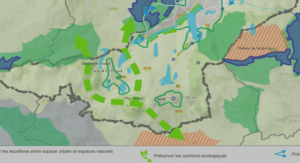La variabilité hydrologique et pluviométrique dans le bassin amazonien
Télécharger le fichier original (Mémoire de fin d’études)
Hydro–climatic characteristics of the Amazon Basin
Rainfall regimes in the Amazon Basin show the strong opposition between the nor-thern and southern tropics, with a rainy season in June, July and August – JJA (in December, January, February – DJF) in the North (South), due to the alternating warming of each hemisphere and to American monsoons. Next to the Amazon delta, a March, April and May (MAM) maximum and a September, October, November (SON) minimum are associated with the seasonal migration of the Intertropical Convergence Zone (ITCZ). In the Northwest equatorial region a better rainfall dis-tribution within the year is observed with quarterly rainfall percentages close to 25%.
Various intermediate regimes are described between equatorial and tropical regions (for more information see Figueroa and Nobre, 1990, Marengo, 1992, Espi-noza et al., accepted, among others). Interannual discharge variability on the Amazon mean stem may cause inunda-tions or very low water stages. For instance, the recent 2005 drought that affected the western sub-basins (Solim˜oes and Madeira Rivers) during the low water stage (October and November) received important attention from the scientific community (Zeng et al., 2008; Marengo et al., 2008) as it had serious impacts on human activity (transport, fishing, water supply, etc) and on the biosphere.
This event is attributed to high sea surface temperature (SST) in the tropical northern Atlantic (Zeng et al., 2008; Marengo et al., 2008), a feature that is also pointed out by Marengo (1992) and Labat et al. (2004). Ronchail et al. (2005b) specify that higher than normal low–flow associated with cold events in the North Tropical Atlantic are particularly strong and wide spread in the central regions of the basin. Interannual discharge variability is also related to the SST in the Equatorial Pacific : authors coincide in finding lower (higher) discharge during El Ni˜no (La Ni˜na) in the main stem (Richey et al., 1989; Marengo, 1992; Marengo et al., 1998). Some works analyzing the regional di-scharge variability inside the Amazon Basin show that the ENSO signal is particu-larly strong in the northeastern basins (Molion and Moraes, 1987; Uvo and Graham, 1998; Guyot et al., 1998; Uvo et al., 2000; Foley et al., 2002; Ronchail et al., 2005b). Ronchail et al. (2005a) also find an opposite ENSO signal in the upper Madeira Ri-ver (southern Amazon).
Richey et al. (1989); Marengo (1995); Marengo et al. (1998) point out that the Solim˜oes River discharge in Manacapuru and the Rio Negro in Manaus do not exhibit any significant trend during the twentieth century but they note that di-scharge increases at the end of the sixties. This feature is also noted by Callède et al. (2004, 2008) in the Amazon River in Obidos ; they find a break in the mean, maxi-mum and minimum discharge times series at the beginning of the 1970s, with higher values after that date. Afterwards, mean and maximum discharge remain high until the beginning of the XXI century while minimum discharge decreases since the mid–1970s.
Consistently, Genta et al. (1998), Garc´ıa and Vargas (1998), Collischonn et al. (2001), Garcia and Mechoso (2005) and Krepper et al. (2008) all find an increasing trend since the early 1970s in the La Plata Basin discharge. At a regional scale, Rocha et al. (1989) highlight that rainfall and discharge in the Ma-deira, the Solim˜oes and the Negro rivers increase during the 1960s and the early 1970s, but the records return to the long-term average values in the late 1970s and 1980s (except in the Madeira River). Espinoza et al. (2006) support a significant diminishing trend in the Peruvian Amazon (at Tamshiyacu station, near to Iquitos) for the 1970–2005 period, especially in the low-level discharge series.
Analyzing Obidos discharge long time series, Labat et al. (2004, 2005) high-light low–flow interdecadal processes (15.5 years) and high-flow bidecadal variability that can be related to the northern Tropical Atlantic and Pacific variability (low– flow) and the Southern Tropical Atlantic variability (high-flow). Garcia and Mechoso (2005) find a 9 year period in the Paraguay–Paran´ River and a dominant quasi oscillation with a period of around 17 years in mean annual discharge in the Amazon at Obidos, in the Tocantins and S˜ao Francisco Rivers. In the southern part of South America, Pasquini and Depetris (2007) find a quasi-decadal variability in the tributaries of the La Plata River, in the Patagonia’s Colorado River and quasi-bidecadal periodicities in discharge of La Plata, Colorado and Santa Cruz Rivers. Robertson and Mechoso (2000) attribute the quasi–bidecadal variability to the 17– year cycle of the South American Monson System.
In conclusion, most authors mention the possible links between long-term di-scharge variability and climate shifts. They generally deny the role of deforestation on the 1970 change as it occurs when deforestation was just beginning in southern Amazonia.
Data and methods
Daily water level data are compiled and their quality is checked by the national insti-tutions in charge of hydrological monitoring in the different countries of the Amazon Basin : Agˆencia Nacional de Aguas (Water National Office – ANA, Brazil) and Servi-cio Nacional de Meteorolog´ıa e Hidrolog´ıa (National Meteorology and Hydrology Ser-vice – SENAMHI, Peru and Bolivia). The rating curves of about thirty stations have been determined using Acoustic Doppler Current Profiler (ADCP) gauging measures conducted by HYBAM researchers between 1996 and 2008. This methodology has been shown to be well adapted to large Amazonian rivers (Filizola and Guyot, 2004). In some stations (Manacapuru, Fazenda Vista Alegre, and Itaituba) discharge is not a simple function of water level due to the backwater effect (Meade et al., 1991). The gauging curves have been established using the normal drop method. It is based on a correction of the water level using the level difference between the given sta-tion and a downstream one and the distance between both (Jacon and Cudo, 1989). Monthly and annual discharge values have been computed using daily data.
In this study eighteen hydrometrical stations are selected based on their water-shed sizes, their mean discharges, their locations in the Amazon basin and their data periods. Some smaller Andean basins are also documented. Table 2.1 and Figure 2.1 display the locations and the main characteristics of the stations. Discharge data is available for different periods, depending on the stations. The common selected period in this work is 1974 – 2004 for the main basins and 1990-2005 for the smal-ler Andean basins. Four stations are located in the South and drain N-S rivers : from East to West, Itaituba (ITA) is on the Tapaj´os River, Altamira (ALT) on the Xingu River, Fazenda Vista Alegre (FVA) and Porto Velho (PVE) downstream and upstream on the Madeira River respectively. The data of two stations, Gavi˜ao on the Juru´a River and Labréa on the Purus River, in the central western Brazilian Amazon, are added in order to create a virtual station Gavi˜o-Labréa (G–L), which has size and discharge of the same order of magnitude as the other stations.
Four stations are located along the Solim˜oes River : Tamshiyacu (TAM) on the Peruvian Amazonas River drains tropical and equatorial regions of Peru and Ecuador, Santo Antˆonio do I¸c´a (SAI) northwestern equatorial regions on the upstream Solim˜oes River, Acanau´ı (ACA) on the Japur´ River the equatorial Colombian Amazon and finally Manacapuru (MAN), the whole Solim˜oes River. Toward North, Caracara´ı (CAR) on the Branco River drains tropical regions in the northern hemisphere while Serrinha (SER) drains the northwestern Negro River basin. Finally Obidos (OBI) on the Amazon River main stem gather water from the Negro, the Solim˜oes and the Madeira Rivers. Two gauging stations put together water from the Andes : 22% of PVE basin area is in the Andes of Peru and Bolivia and 53% of TAM basin area is in the Andes of Peru and Ecuador. PVE and FVA gauging stations have part of their watershed in the Brazilian shield. ITA and ALT are completely in the Brazi-lian shield and finally CAR and SER watersheds are partly located in the Guyana Shield.
Five complementary stations in Peru and Bolivia are used to give more detailed information about the Andean sub-basins (Table 2.1 and Figure 2.1). San Regis discharge in Obidos for thirteen main stations (top), one virtual station (G–L), five Andean river stations (middle) and five residual stations noted with an * (bottom). Altamira and Itaituba sub-basins, on the Xingu and Tapaj´os Rivers respectively, are not part of the Amazon basin in Obidos.
(SRE) and Borja (BOR) are located on the Mara˜n´on River that drains northern Peru and part of Ecuador. Requena (REQ) on the Ucayali River drains southern Peru. The Ucayali and Mara˜n´on Rivers form the Amazonas River where is located TAM. Upstream PVE on the Madeira River, Guayaramer´ın (GUA) on the Mamoré River and Cachuela Esperanza (CAE) on the Beni River drain lowlands and moun-tain regions in Bolivia and Peru.
Five supplementary stations are created in order to give information about the contribution and the variability of parts of large sub-basins. They are called “re-sidual” stations. Their discharges are the difference between a downstream and an upstream station discharges. In the residual Santo Antˆonio do I¸c´a station (SAI*), it is the difference between discharge in SAI and TAM, and in the residual Fazenda Vista Alegre (FVA*) station, it is the difference between discharge in FVA and PVE. The residual Manacapuru (MAN*) discharge is the difference between MAN and the sum of SAI, G-L and ACA discharges. The residual Obidos (OBI*) corresponds to the difference between OBI and the sum of CAR, SER, MAN and FVA discharges. Finally, in the Andean sub-basins, the discharge in the residual San Regis station (SRE*) is the difference between discharge in SRE and BOR (Table 2.1 and Figure 2.1).
In order to compare the discharge in the different basins, the runoff in milli-meters (mm) is computed for each station. Particular values such as the monthly maximum and minimum annual runoff (Qmax and Qmin respectively) are individua-lized and complement the mean annual runoff (Qmean). The interannual variation coefficients, ratio between the standard deviation and the average of annual data values, are calculated for each hydrological series (iVCQmean, iVCQmax and iVC-Qmin respectively). The seasonal variation coefficients (sVC) is the ratio between the standard deviation and the average of monthly values. The seasonal amplitude is computed by subtracting Qmin to Qmax. Maximum and minimum discharge data are not available for residual basins because the difference between extreme values in downstream and upstream stations may be negative, as there is a time lag bet-ween the occurrences of extremes in the different sub-basins. SAI* is an exception, as it is close, for the Amazon basin standards, to the upstream TAM station (1000 km).
The Southern Oscillation Index (SOI), the standardized difference of pressure between Tahiti and Darwin, comes from the Climatic Prevision Centre of the Na-tional Oceanic and Atmospheric Administration (CPC-NOAA) www.cdc.noaa.gov/. SST data also comes from the CPC-NOAA. Monthly SSTs (1950-2000) are provi-ded for the northern tropical Atlantic (NATL, 5-20◦N, 60-30◦W) and the southern tropical Atlantic (SATL, 0-20◦S, 30◦W-10◦E). The standardized SST difference bet-ween the northern and the southern tropical Atlantic (NATL-SATL) is computed to feature the SST gradient in this oceanic basin.
A homogeneous gridded monthly rainfall data set for the entire basin (0.25 x 0.25◦) and the 1975 – 2003 period is constructed using raingauge data collected in the frame of the HYBAM program. 756 stations’ data are used to compute gridded rainfall using the Kriging method (Espinoza et al., accepted).
Water level data management, rating curves processing and discharge calcu-lation have been realized using HYDRACCESS software (Vauchel, 2005) built up within the HYBAM program (free download in http :// www.mpl.ird.fr/hybam /ou-tils/hydraccess). The geographic extents of the main watershed and subwatersheds, and the river network were estimated using the SRTM (Shuttle Radar Topography Mission) Digital Elevation Model (Rabus et al., 2003), with a resolution level of 3 arc sec (∼90m), using the Hydrological Modelling and PrePro2002 (Olivera et al., 2002) ArcGIS extensions.
Breaks and changes in the series are evaluated through different methods. The Bayesian Buishand method (Buishand, 1982), which is valid even for variables with different from normal distributions, is based on changes of series averages ; critical values for the identification of breaks are based on the Monte Carlo method. The Pettitt method (Pettitt, 1979) is a non-parametric test based on changes in the ave-rage and the range of the series subdivided into sub-series ; it is considered one of the most complete tests for identification of changes in time series (Zbigniew, 2004). The Lee and Heghinian Bayesian test (Lee and Heghinian, 1977) uses the average as an indicator of change thanks to an a posteriori Student’s distribution. Finally, Hubert segmentation (Hubert et al., 1989) verifies whether differences in average and standard deviation among periods are significant ; it is very appropriate for the search of multiple changes in the series. In this work, a break is identified when it is detected by all the tests. The calculation of changes in the series is made using the KHRONOSTAT software (IRD, 2002).
Trend in the different time series has been evaluated using Pearson “r” and rank correlations. The main reason for using both tests is that the non – parametric rank test is more suitable for non – normally distributed data, which are frequently en-countered in hydrological time series. The Spearman “ρ ” test (Siegel and Castellan, 1988) is a rank – based non – parametric test that can also be used to detect mono-tonic trend in a time series. The application of this test in hydro meteorological se-ries has been mentioned by Pilon et al. (1985); McLeod et al. (1991), among others. The rank – based non – parametric Kendall test “T” (Kendall, 1975) is also applied. This test has been more commonly used to assess the significance of trend in hydro meteorological series (Hirsch et al., 1982; Cailas et al., 1986; Gan, 1998; Yu et al., 1993; Zhang et al., 2000, 2001). Yue et al. (2002) computed the power for both non – parametric tests and found a positive relationship between the test power and the sample size, the trend slope and the pre – assigned significance level, while the power is a decreasing function of the time series variance. The power test is also dependent on the distribution of the sample. They concluded that the Kendal and Spearman tests have a similar power in detecting a trend in hydro meteorological data series.
An index for trend measure is calculated using Eq 2.1, where b is the slope of the linear trend and X is the mean value in the series.
Finally the spatial and temporal structure of the interannual runoff variability is examined based on a Principal Components Analysis (PCA) (Dillon and Goldstein, 1984) on the Qmax, Qmean and Qmin time series for the 1974 – 2004 period. The applied PCA is rotated Varimax type to avoid the exaggerated spatial influence of variables that highly contribute to the definition of the factors (Richman, 1986; Dommenget and Latif, 2002).
Discharge spatial variability and the genesis of the Amazon River regime at Obidos
As the Amazon drainage basin has a continental dimension and is present in both hemispheres, it includes regions with various rainfall and consequently discharge re-gimes (Figure 2.1). A southern tropical regime, with a maximum flow from March to May and a minimum from August to October, is observed in the southern basins (PVE, FVA, G-L, ALT and ITA). In contrast, a northern tropical regime characte-rizes CAR with a maximum from June to August and a minimum from December to March. Seasonal Variation Coefficient (sVC) are high in the South (about 0.60 in PVE, G–L and ITA) and in the extreme North and South (0.74 in CAR and 0.88 in ALT where the climate is very dry in austral winter) (Table 2.1). In the other stations (TAM, SAI*, ACA, SER and OBI), the annual cycle is weaker than in tropical regions closer to the Ecuator line. High water discharge occurs generally from May to July and a month sooner in TAM, where part of the basin is tropical, and low water discharge is observed from September to November and a month sooner in TAM.
In these basins the sVC values are low, between 0.26 and 0.35. In OBI the sVC value is low, influenced by the northwestern stations that provide the greatest quantity of water to the mean stem, but also by the lagged combination of the tributaries’ flows, creating a dumped hydrogramm downstream with a large and unique flood. The various discharge regimes are in accordance with the rainfall seasonality (Salati et al., 1978; Figueroa and Nobre, 1990, Espinoza et al., accep-ted; among others) and with discharge regimes described by Molinier et al. (1996); Laraque et al. (2007); Marengo et al. (2008)
Three years’ daily discharge data (1994-1996) are presented for OBI on the main stem, a northwestern sub-basin (SAI, 1870 km from OBI), a northern sub-basin (SER, 1370 km from OBI) and a southern sub-basin (PVE, 1630 km from OBI) (Figure 2.2 a). In PVE the tropical annual cycle is contrasted. Two to three months lag are observed between PVE and OBI extremes. The annual cycle in SER and SAI presents irregular peaks at the beginning of the year ; they precede the June annual peak and feature the semi-annual cycle also detected in OBI (Labat et al., 2005) and in Ecuador (Laraque et al., 2007). The seasonality is weaker in these stations, as well as in OBI. There is a one to two month time lag between SAI and OBI extremes, SAI preceding, OBI and one month time lag between OBI and SER, OBI preceding SER.
At annual time scale 40% of OBI discharge comes from the southern basins, that is to say 52% of the OBI drainage basin (PVE, TAM, FVA* and G–L. Table 1), while 34% comes from SAI*, ACA, SER and CAR (23% of the OBI drainage basin) and 26% comes from the central residual basins, MAN* and OBI*, that account for 25% of the OBI drainage basin. The respective contributions of the sub-basins to OBI runoff minus the central residual basins (FVA*, MAN*, OBI*) runoff, change during the year according to the different annual cycles (Figure 2.2 b). During the first part of the annual cycle in OBI, southern rivers are those which contribute more to the main stem discharge. PVE and G–L first experience its maximun contribu-tion in March and TAM in April. At the same time, discharge is rather low in the northern stations.
Afterwards, discharge decreases in the southern stations while it increases in the northern stations. SAI* has a maximum contribution in July, and in August–September in ACA, SER and CAR. Discharge then decreases in the North, while it is very low in the South after the dry season and OBI experiences its annual low-flow discharge (November). The contributions of the northern and the southern basins are equivalent because the smaller northern basins are rainier than the large southern basins (Table 2.1 and Figure 2.2 b).
The interanual variability (iVC) of Qmean, Qmax and Qmin presents the same regional structure as the seasonal variability. iVCQmean is about 0.10 in the western and northwestern basins (TAM, SAI*, ACA, SER, G-L and OBI). Values are higher, between 0.14 and 0.20, in the central and southern regions (PVE, ITA, MAN*, FVA*). Much higher values are detected in the extreme North (0.27 in CAR), in the southeast (0.22 in ALT) and in the east (0.31 in OBI*). That is to say, the regions that are close to the Atlantic Ocean and are responsive to ENSO and Atlantic varia-bility (Uvo and Graham, 1998; Guyot et al., 1998; Uvo et al., 1998; Ronchail et al., 2005b), etc).
As seasonal and interannual variability display the same spatial features, they are related in Figure 2.3. The northwestern stations and OBI are all situated in the left part of Figure 2.3, indicating low seasonality and interannual variability. In the southern stations the seasonal and interannual variability is medium and it is very high in the extreme North and Southeast. Two stations are off–centered. G–L basin displays a relatively low interannual variability, perhaps owing to its numerous and large flooding plains. The interannual variability in CAR on the other hand is rela-tively strong.
Runoff evolution during the 1974–2004 period
Qmean, Qmax and Qmin annual runoff evolutions are displayed in Figures 2.4 a and b, for the southern and northern stations respectively. Annual values are computed in function of the hydrological cycle of each station.
Break tests applied to the 1974–2004 runoff series point out ruptures in the Qmin series of PVE and TAM in 1992 and 1986 respectively and in the Qmax series of SAI* in 1992 (Table 2.2). Qmax increases at SAI* from 2150 mm/yr during the seventies to 2500 mm/yr at the beginning of the XXI century, that corresponds to a 16% increase. In the South, Qmin in PVE changes from 150 mm/yr during the seventies to 100 mm/yr at the beginning of the XXI century and from 780 to 580 mm/yr in TAM ; it corresponds to an 18% runoff diminution in both stations. An interpretation of this long–term variability is proposed in section 7.
Trend tests are presented in Table 2.3 and Figure 2.5. In the South, annual and extreme runoff values diminish everywhere. Qmean and Qmin diminutions are si-gnificant at the 99% level in TAM, PVE, and ITA, that is to say in the extreme southern, Amazonas, Madeira and Tapajos basins (Figure 2.5 b and c). Qmean in the whole FVA basin also significantly diminishes ; as Qmean in the residual FVA* basin does not significantly decrease, it can be concluded that the important Qmean dimi-nution in the Madeira River occurs upstream (PVE, Figure 2.5 b). The Qmin runoff diminution in PVE, TAM and ITA (see trend Index in Table 2.3) is about 1.30% per year. The Qmean runoff diminution is less important, about 0.65% per year, in the three stations. In the South, the Qmean 1974 – 2004 diminishing trend partly cor-responds to a comeback to lower runoff values after the 1970s peak (Marengo et al., 1998; Callède et al., 2004). Trend runoff analysis before and after the 1992 and 1986 Qmin breaks respectively in PVE and TAM shows negative trends before the change in both stations and stable runoff afterwards.
In the northern basins, the main signal is in the upper Solim˜oes, Napo and Putumayo Rives at SAI* (Figure 2.5 a and b), where Qmax and Qmean runoff dra-matically increase during the 1974–2004 period, though not regularly : discharge first decrease until the mid 1980s and then strongly increases (Figure 2.4 b). The trend Index is 0.75 and 0.83% per year for Qmax and Qmean respectively. A weak Qmin diminution is observed in SAI* (Figure 2.5 c). There is no trend in SAI* before and after the 1992 break. In this station the amplitude trend is positive and significant at the 99% level. In the whole MAN basin there is no Qmean trend as Qmin slightly decreases and Qmax slightly increases ; this also occurs in the residual MAN* basin. That means the slight variations do not arise from the residual MAN* basin but from upstream basins.
The comparison between our results and those from other authors (Richey et al., 1989; Marengo et al., 1998) is difficult as we work on a shorter and more recent per-iod (1974–2004). In addition, the main signals are found in western basins that have not been documented before (upper Madeira and upper Solim˜oes). However, the lack of trend in the Negro River is similar to the results by Marengo et al. (1998).
In OBI the amplitude slightly increases. This is because Qmin decreases slightly and because Qmax remains constant and high since the middle of the seventies, after the 1970s break. The amplitude increase in Obidos is associated with the Qmin decrease in the Madeira and Amazonas River and to the Qmax increase in SAI* (Figure 2.4 and 2.5) and it is particulary strong after the break in PVE and SAI* (Table 2.2). The Qmean stability in OBI, in spite of the Qmean significant increase in SAI*, is consistent with the absence of trend in OBI*, MAN*, CAR, SER, ACA and the slight decreases observed in the southern basins (PVE and TAM). Finally, the absence of Qmean trend in OBI does not represent the strong and opposite trends into the different watersheds. FIGURE 2.5 – Pearson (r), Spearman rho (ρ) and Kendall Tau (T) coefficients bet-ween runoff and time (1974-2004) in the sub-basis of the Amazon for a) the annual maximum values (Qmax), b) the mean annual values (Qmean), c) the minimum values (Qmin). Values above 0.30 are significant at the 90% level and above 0.45 at the 99% level. The colors indicate the sign and the strength of the trend : red is for negative trend and dark blue is for positive trend.
Diversity of runoff variability in the Andean Region (Bolivian, Pe-ruvian and Ecuadorian Amazon Basin).
The basin delimited by TAM station has a 726 400 km2 area (15.5% and 18.8% of ´ Obidos basin surface and discharge, respectively). Half of it is located in the Andes (above 500 masl) and it features an important meridian extension, from 0.50◦S near the Equator until 15.60◦S in the tropics. Due to its latitudinal extension and its relief, different climates are observed in this basin (Espinoza et al., accepted). TAM is located downstream from the confluence of the Ucayali River that comes from the South and of the Mara˜n´on River that flows from the West (Figure 2.6). San Regis (SRE, 43% in the Andes) on the Mara˜n´on River and Requena (REQ, 50% in the Andes) on the Ucayali River, account for the same annual discharge (about 14 000 m3/s, Guyot et al. (2007)). San Regis basin includes northern sub-basins with rivers flowing from Ecuador (Santiago, Pastaza and Tigre Rivers) and the southern Huallaga River, while Requena only receives water from the South. Upstream SRE, on the Mara˜n´on River, the Borja gauging station (BOR, 90% in the Andes) is located in the Andean piedmont. Its basin also has a North – South extension (from 2.00◦S to 10.50◦S) and displays complex rainfall regimes, some of them unimodal and others bimodal (Laraque et al., 2007).
Table des matières
CHAPITRE Introduction
1.1 Contexte général
1.2 Les programmes de recherche dans lesquels s’inscrit la thèse
1.3 Objectifs de la thèse
1.4 Organisation
CHAPITRE 2 La variabilité hydrologique dans le bassin amazonien
2.1 Introduction
2.2 Contrasting regional discharge evolutions in the Amazon basin
2.3 Résultats complémentaires
CHAPITRE 3 La variabilité pluviométrique dans le bassin amazonien
3.1 Introduction
3.2 Principaux éléments de la circulation atmosphérique
3.3 Variabilité spatio–temporelle de la pluie dans le bassin amazonien
3.4 Spatio-temporal rainfall variability in the Amazon basin
3.5 Résultats complémentaires
3.6 Variabilité pluviométrique et relations avec les débits
3.7 Variabilité pluviométrique et relations avec la SST
3.8 En résumé
CHAPITRE 4 Types de temps et désagrégation dans le bassin amazonien
4.1 Introduction
4.2 Concepts généraux
4.3 Cartes topologiques auto–organisatrices
4.4 Application dans le bassin amazonien
4.5 Conclusions
CHAPITRE 5 Types de temps : facteurs explicatifs de l’hydrologie
5.1 Evolution des types de temps et relations avec la pluie
5.2 Types de temps et événements hydrologiques extrˆemes
CHAPITRE 6 Conclusion générale et perspectives
6.1 Conclusions
6.2 Perspectives
CHAPITRE Annexe
La variabilité du débit du Rio Amazonas au Pérou
Bibliographie






